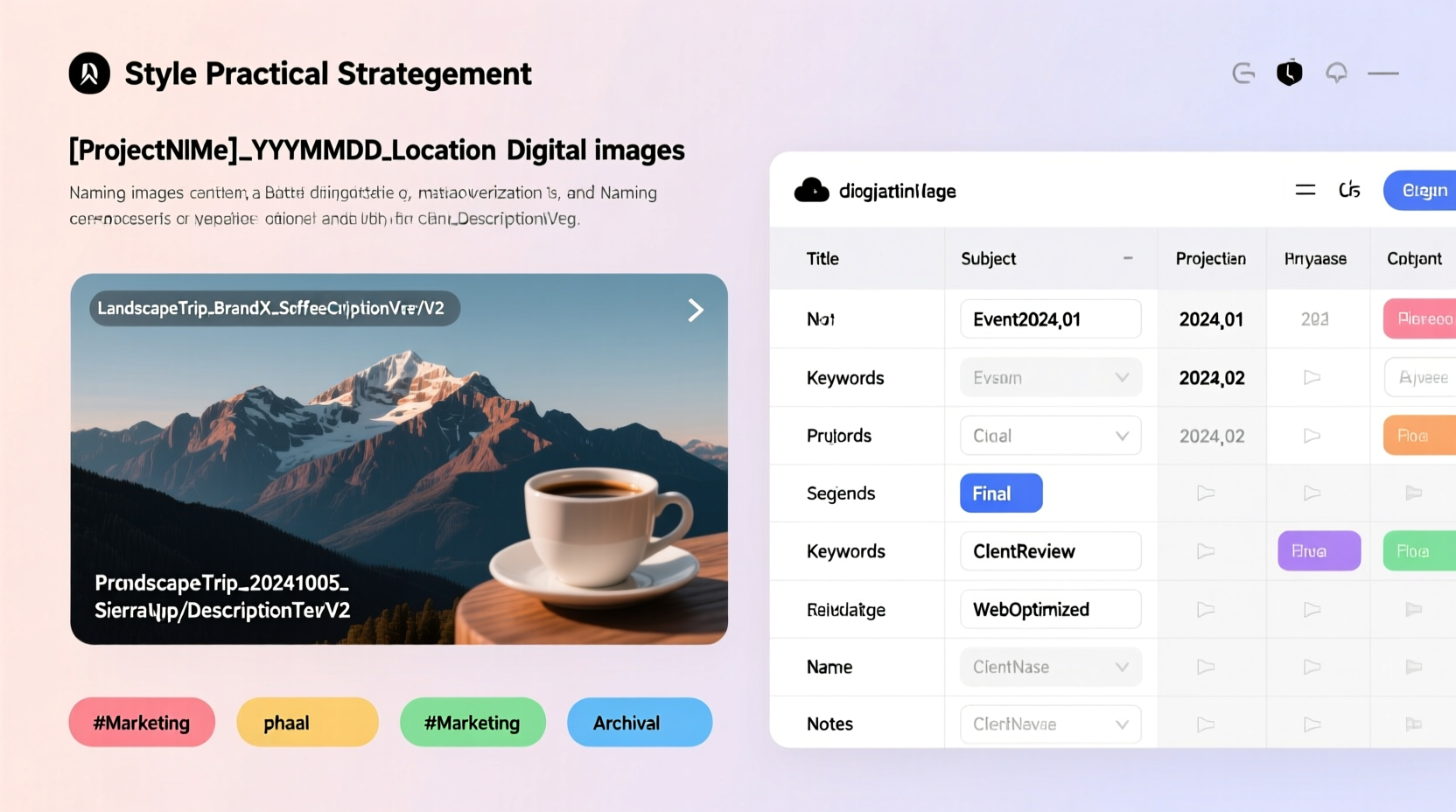In a world where digital photography is ubiquitous, the average person accumulates thousands of images across devices and cloud platforms. Yet, many struggle to locate specific photos when needed. The root cause? Poor or inconsistent file naming. A well-named image does more than just identify a moment—it becomes searchable, shareable, and future-proof. Thoughtful picture naming is not about rigid rules but strategic clarity that supports both personal memory and professional workflows.
Why Picture Naming Matters More Than You Think

Most people rely on timestamps or default camera names like “IMG_4567.jpg,” which offer no context and degrade over time. Without meaningful labels, even precious memories can become digital clutter. Effective naming transforms disorganized folders into structured archives. It improves search engine visibility for photographers publishing online, simplifies collaboration with clients or team members, and ensures long-term accessibility as technology evolves.
Consider this: a photo titled “BeachSunset2023.jpg” tells you more than “DSC_0987.jpg.” But go further—“Italy_CinqueTerre_SunsetGoldenHour_2023-06-18_VeniceTrip.jpg” embeds location, subject, mood, date, and project. This level of detail turns a generic file into a self-contained record.
“Metadata starts with the filename. A descriptive name is the first layer of digital preservation.” — Dr. Lena Torres, Digital Archivist at the National Media Preservation Institute
Core Principles of Effective Picture Naming
Successful picture naming balances consistency, clarity, and scalability. Follow these foundational principles to build a system that lasts:
- Use consistent formatting: Stick to one structure (e.g., Location_Event_Subject_Date).
- Avoid spaces and special characters: Replace spaces with underscores or hyphens; avoid symbols like ?, *, :, |.
- Include dates in ISO format: Use YYYY-MM-DD to ensure chronological sorting.
- Keep it concise but descriptive: Aim for clarity without excessive length.
- Make it human- and machine-readable: Your future self and any software should understand the name.
Step-by-Step Guide to Building Your Naming System
Creating a personalized yet scalable naming convention takes planning. Follow this five-step process to design a system tailored to your needs:
- Define your categories: Identify what information matters most—location, event type, client name, shoot purpose, or subject.
- Prioritize order: Arrange elements logically. For example: Project_Location_Date_Sequence.
- Standardize abbreviations: Create a shortlist of approved codes (e.g., POR = portrait, WED = wedding, STUDIO = studio session).
- Test with real files: Apply your system to 20–30 existing images and refine based on usability.
- Document the rules: Save your naming protocol in a text file or note app for reference and sharing.
Example Structure for Different Use Cases
| User Type | Naming Convention | Sample Filename |
|---|---|---|
| Travel Photographer | Country_City_Subject_YYYY-MM-DD_Sequence | japan_kyoto_cherryblossoms_2023-04-05_01.jpg |
| Family Historian | FamilyName_Event_Relative_YYYY-MM-DD | miller_familyreunion_grandma_ann_2022-08-12.jpg |
| Professional Photographer | ClientID_SessionType_Location_YYYYMMDD_Sequence | smith_wedding_outdoor_20231014_001.jpg |
| Freelance Content Creator | ProjectName_Purpose_Date_Version | website_redesign_hero_banner_2023-11-03_v2.jpg |
Creative Strategies to Add Value Beyond Organization
Beyond basic sorting, clever naming can elevate how images are used and perceived. Consider these advanced tactics:
- Embed storytelling cues: Include emotional or contextual keywords like “goldenhour,” “candid,” or “firstkiss” to evoke memory.
- Use version tags: Append “_edit,” “_final,” or “_web” to distinguish iterations.
- Integrate SEO-friendly terms: For public-facing images, include relevant keywords (e.g., “sustainable-fashion-model-walk”)
- Leverage sequences: Use three-digit numbering (001, 002) for series, ensuring correct sorting.
Mini Case Study: From Chaos to Clarity
Sarah Kim, a freelance photographer based in Portland, once managed over 12,000 unsorted images across six hard drives. She couldn’t reliably find client work or past projects. After implementing a standardized naming system—using Client_Lastname_ShootType_Date—she reduced search time by 80%. She also began adding brief descriptors like “outdoor_portrait” or “product_flatlay,” which improved client delivery accuracy. Within three months, her workflow became streamlined enough to take on 30% more assignments without added stress.
Essential Checklist for Naming Pictures Effectively
Before finalizing any batch of images, run through this checklist to ensure quality and consistency:
- ✅ Remove default camera filenames (e.g., DSC_, IMG_)
- ✅ Format date as YYYY-MM-DD
- ✅ Use only letters, numbers, hyphens, or underscores
- ✅ Limit total filename length to under 60 characters
- ✅ Include at least two identifying elements (e.g., location + subject)
- ✅ Sort test files alphabetically to verify chronological integrity
- ✅ Backup renamed files before deleting originals
Common Mistakes and How to Avoid Them
Even experienced users fall into naming pitfalls. Watch out for these frequent errors:
- Duplicate names: Always add a sequence number or unique descriptor.
- Overloading with info: Avoid “MomBirthdayPartyRedBalloonJohnLaughing2023…”—it’s unusable.
- Inconsistent capitalization: Mixing CamelCase, lowercase, and UPPERCASE breaks sorting.
- Ignoring future use: Name files so someone else could understand them years later.
“Good naming isn’t perfection—it’s intentionality. One clear decision per file compounds into powerful organization.” — Marcus Reed, Workflow Consultant for Creative Professionals
Frequently Asked Questions
Can I rename pictures in bulk?
Yes. Use built-in tools like macOS Preview, Windows File Explorer, or free software such as Bulk Rename Utility (Windows) or Renamer (macOS). Many photo editors like Adobe Bridge also support batch renaming with templates.
Should I include my name or brand in the filename?
Only if sharing publicly or submitting to stock platforms. For private archives, it adds unnecessary clutter. Instead, store ownership in metadata (IPTC/XMP), not the filename.
What if I’m organizing old photos with no context?
Start by grouping similar images (e.g., holidays, seasons). Assign educated guesses with qualifiers like “[possibly]” or “unknown-family-1980s.” Over time, consult relatives or use AI-powered tagging tools to recover details.
Final Thoughts: Turn Files Into Assets
A well-named picture is more than an organized file—it’s a retrievable memory, a reusable asset, and a reflection of professionalism. Whether you’re archiving family moments or managing a commercial portfolio, investing time in a smart naming strategy pays dividends for years. Systems don’t have to be perfect; they just need to be consistent and intentional.









 浙公网安备
33010002000092号
浙公网安备
33010002000092号 浙B2-20120091-4
浙B2-20120091-4
Comments
No comments yet. Why don't you start the discussion?